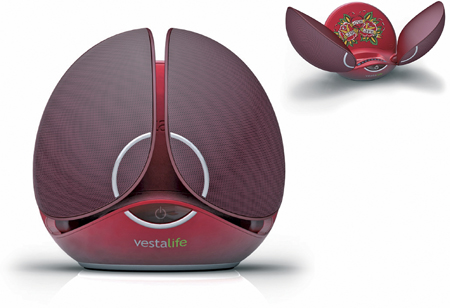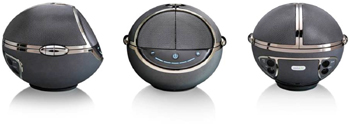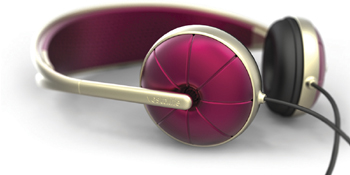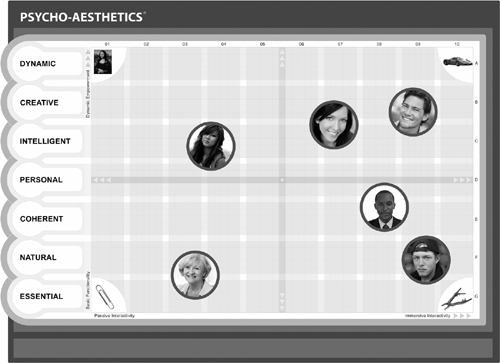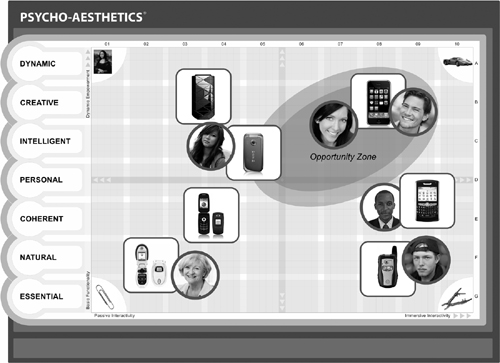5 Own the Opportunity
Identifying emerging opportunities requires understanding gaps in which consumer emotions and desires are not met by current industry offerings; this reveals a new, uncontested market space. This leads to specific design priorities for target personas to guide the development process and maximize market share.
On a Wing and a Startup Prayer
In 2007, startup Vestalife debuted with the introduction of the Ladybug iPod speaker dock created and designed by LDA. The engaging little device got its name because it looks like a ladybug— the friendly little insect seen as a sign of good luck in many cultures. When closed, the Ladybug is a sphere a mere 5 inches in diameter. But with its “wings” unfurled, the speakers span a full 13 inches. The engaging character and design of the Ladybug struck an ideal balance between playful and sophisticated. By so doing, the Ladybug connected with the primary target market of younger kids, yet still appealed to adults looking for an out-of-the ordinary speaker dock.
Among hundreds of offerings in the crowded category, the Lady-bug stood out, quickly becoming a media darling as it won both an iLounge 2008 MacWorld Best of Show and a 2008 International Consumer Electronics Show (CES) Innovations Design and Engineering Award. According to iLounge’s editor-in-chief, Jeremy Horwitz, “Vestalife’s Ladybugs…are the extremely rare ‘more than the sum of their parts’ iPod speakers…. This is, without question, one of the best iPod speaker designs we have seen in the past six years.”1
Although this early success and attention was gratifying, it also presented a challenge: How could Vestalife best follow up on the Ladybug and capitalize on its growing brand recognition?
Although it’s hard enough for a young business to generate its first success, it can be as hard, or even harder, to get that second hit…to prove that the first “win” wasn’t just a matter of “ladybug” luck. After all, 50 percent of all new businesses fail in their first 5 years.2 But it’s not just startups who fumble follow-up offerings—witness Motorola’s inability to build on the success of the Razr.
For startups looking to repeat initial success, the game changes measurably from the initial toiling in anticipation of its first release. After delivering a hit, the barrier for entry has been lowered, but the risk is higher. In the early stages, entrepreneurs may be risking every cent they own. Later, they are also risking the brand equity built with the first hit. Vestalife founder Wayne Ludlum wanted more than one break-out hit; he was determined to build an enduring brand. It was a classic test of the adage “once you’re lucky, twice you’re good.” His follow-up to the Ladybug would determine Vestalife’s ultimate success or failure.
Understanding a Changing Landscape
When Vestalife was looking to create its next line of products, the market was rapidly changing. Speaker docks for iPods were just one of the major categories of products that were created from the phenomenal success of Apple’s iconic MP3 player. In this crowded category, the iPod was the clear leader, and the accompanying iTunes store only amplified its success. By mid-2008, Apple announced that more than 5 billion songs had been downloaded in the 5 years since the iTunes store began operation.3 Earlier the same year, iTunes surpassed Walmart as the largest music distributor in the United States.4 The iPod line of media players went from a widely recognized design success to a huge commercial one as well—boasting global sales of 220 million units.5
There was no question that plugging into the iPod ecosystem was a big opportunity. However, a host of competitors and Apple itself were eager to take advantage of the growing market in accessories related to the iPod. To make an impact, Vestalife would need to create a design that could hold its own next to a design leader such as Apple. It also had to do so by creating a niche that could help Apple, one of the most marketing-savvy companies in the world, connect with an important audience.
The MP3 player market attracted a broad range of consumers including professionals, commuters, and fitness enthusiasts. At the same time, the character of the online music market was maturing and trends once driven by teenagers were migrating to older age groups. Furthermore, a majority of the traffic on music sites—56%— now comes from women.6
As early as 2006, the tech industry began to show an inflection point and the power of women in the technology sector became more apparent. In coining the term “Tech Fatales,” Microtrends authors Mark Penn and E. Kinney Zalesne highlighted the following trends about female technology consumers:
“Women outspend men on technology 3 to 2, and influenced 57% of technology purchases (about $90 Billion) in 2006. They pointed out that girls were more likely than boys to use mobile phones, digital cameras, satellite radios, and DVD recorders. The only category where girls were lagging was in the Portable MP3 player and videogame console markets. He concludes, “In study after study, women express different priorities, different preferences, and different concerns regarding technology. They want their gadgets light, durable, and effective—not fast, sharp, and zillion-faceted…girls and women are deeply open to technology as fashion….
“Someday soon, someone is going to come along and tap into a fundamentally different way, and walk off with not just a niche market, but the largest and fastest growing piece of the tech puzzle. If you are a Tech Fatale, you are not alone…you are just waiting for someone out there to hear you.”7
Penn and Zalesne point to hits such as the Wii and Dell’s design revamp as examples of technology specifically designed to appeal to both genders. The early success of the Ladybug gave Vestalife a taste for the value of looking out for new consumers. However, its early choice of market was too specialized to create a mass-market success. Going forward, the company and the design team knew a few things for sure: The new offering had to connect with a female audience, yet appeal to young men as well; the Apple store channel was critical for success and visibility; and the new offering had to allow for personal expression in the same way that downloading your own songs did.
Finding the Opportunity for Follow-Up
Vestalife knew their second-year offerings had to more than live up to Ladybug’s initial promise as it sought to expand its product line. To do this, Vestalife enlisted our team to help them identify and connect with new opportunities in the market.
Psycho-Aesthetics® mapping of the competitive landscape for iPod speaker docs revealed current offerings consisted of products whose design language was largely defined by black and white, rectangular, flat shapes. Most of the competition was still following Apple instead of the consumer and drawing inspiration from the iPod design for the accessories.
The team then examined the universe of iPod users. Ladybug had targeted younger kids and tweens, one category of underserved consumers. The remaining options in the market appealed largely to an older, more pragmatic, and mostly male audience, with spare aesthetics and a clear reference to technology. But in the upper-right quadrant, there was a clear opportunity to keep the original Ladybug audience engaged as they matured and begin to draw in older demographics who wanted more sophistication. The primary targets of teenage girls and young women were chosen, with young men as secondary targets. Young men already had some existing product offerings that were designed for them. A common thread among all the target consumers was the need to stand out in a crowd and the desire to express their individuality. With this understanding firmly in mind, the team set a manifest to create designs to connect not just with iPods, but also with the targeted iPod users.
Though Vestalife had planned to develop only one speaker dock follow-up in 2009, it fell in love with two separate preliminary designs: Firefly and Mantis. The Firefly design presents an intriguing, organic shape in sophisticated style that would hold appeal for both the male and female targets, as shown in Figure 5.1. Mantis, on the other hand, was designed to connect more deeply with the identified female personas, as shown in Figure 5.2. This design drew inspiration from the famed Fabergé eggs, known for their artistry, rich detail, and for the promise of a hidden surprise.
Both designs built on the original Ladybug. Angled, hidden hinges enable Firefly speakers to open, not just to the sides, but also moving slightly forward, in a welcoming posture. Mantis opens like a jewelry box to reveal the “hidden magic” of the speakers and the iPod dock.
On both systems, interchangeable faceplates were created in which consumers could embellish the speaker dock. This enabled users to customize their Firefly to help communicate their own personal passions. This interchangeable faceplate option also enables Vestalife to continue powerful cross-pollinations like the ones they conducted with Element Skateboards and luxury retailer Henri Bendel. The need for personalization was addressed, and an important secondary market was created—custom decal designs made by artists that can be used to embellish the faceplate.
© RKS Design
Figure 5.1 Vestalife Firefly (designer’s rendering)
© RKS Design
Figure 5.2 Vestalife Mantis
As a result of its research, the team saw more opportunities to connect with this new audience. A product proliferation plan was developed to create headphones and earbuds that built on the design language and attributes of the speaker docks. Our designers realized that this could provide maturing Vestalife consumers a continuing connection to the brand.
The designs created were targeted to style-conscious young women, and the intent was to bring the appeal of fashion and jewelry to this category. Mapping of competitor products, which were largely sporty or technology driven designs, confirmed the strategic opportunity to bring higher fashion to the headphone and earbud markets. These designs would require a classic elegance to connect emotionally with these fashion-forward young trendsetters.
When you think of headphones and fashion, there is an immediate clash. Most headphones ruin hairstyles. Our designers took this age-old problem and turned it into a solution. With its built-in fashion headband, the Pi headphone becomes part of the hairstyle and has fabric-covered, interchangeable headband inserts. This enables people to express their individuality by how they choose to personalize their headphones. The insert can easily be swapped out, so users can match their headphones to their style or look for the day. For the ear-buds, the team created three designs, each with its own style, all of them looking less like earbuds and more like earrings, as shown in Figure 5.3.
© RKS Design
Figure 5.3 Scarab, Boa, and Bumblebee earbud designs (top to bottom)
Taking a cue from high fashion, all three styles feature the embossed Vestalife logo in a prominent location. With more traditional earbuds, the design stops at the body. With Bumblebee, Scarab, and Boa, the team chose to bring attention to the cord, treating it, too, like jewelry that was meant to be displayed, not hidden. By wrapping the cord in fabric, it is transformed from an unsightly piece of electronics into something that evokes the look and feel of a necklace. Every aspect of the Vestalife earbuds are meant to be seen, not just heard. Finally, because these earbud designs are based in fashion, offering a “family” of three earbuds encourages buyers to get multiple sets for multiple looks.
A Market Winning Strategy
In sneak previews, the Pi headphones and the Bumblebee, Scarab, and Boa earbuds have piqued press interest and garnered retailer pre-orders far in excess of projections (see Figure 5.4). These designs combined with Firefly and Mantis help Vestalife place not only the iPod speakers, but also all its products in Apple stores worldwide.
© RKS Design
Figure 5.4 Pi headphones
Opportunity Is Where You Find It
For Vestalife, plugging into the Apple product civilization offered the best opportunity for the small company to have a chance at long-term success. This understanding informed the choices it made along the way. As resources and target consumers become more abundant, the choices are not always so clear-cut. The first step to capitalizing on an opportunity is to find it. Successful innovation requires identifying the right consumers, strategies, and designs. It is inefficient and usually ineffective to address these challenges as separate tasks. Crafting a coherent strategy becomes easier and less risky when consumers and competitive offerings are evaluated in concert. Doing so reveals what is lacking in the market based on personality and emotional needs. This gap in the competitive landscape that is populated by consumers with unmet needs and aspirations is what we call the Opportunity Zone. The Opportunity Zone is the result of combining insight about markets and consumers to discover unmet needs. This enables for the creation of experiences that capture consumer imagination as they capture market share.
The Benefits of Mining the Gaps
The innovation process is and always will be a process of discovery. However, given the time and effort required to bring a concept to market, it shouldn’t be a matter of chance. The beauty (and benefits) of mining the gaps represented by opportunity zones are many-fold. Using Psycho-Aesthetics to find and connect with unserved consumers laser-focuses the development process, creates deeper connections with consumers, and reveals new paths for innovation.
• Focusing the development process—Bill Cosby once said, “I don’t know the key to success, but the key to failure is trying to please everybody.” Although Cosby may be an unlikely business sage, he makes a valid point. Trying to please all consumers will only lead to the development of products that are met with resounding indifference. Setting too many design priorities wreaks havoc with both the process and the result.
On the other hand, a clear and compelling vision can bring the impossible within reach. For example, the Tata Nano saw a global opportunity in creating a $2,000 car; MySpace created a platform for teenagers seeking both to define themselves and belong to a community; and the Flip camcorder won by introducing a new level of simplicity and a better consumer experience. Understanding the desired goals and outcomes establishes a clear target that all parties can aim for before the development process begins.
• Connecting with consumers—You can’t connect with consumers until you know who they are. After you identify who falls into the Opportunity Zone, it’s a fairly simple step to get to “how” to connect with them. In fact, you’ve already identified how to connect with each of your personas. Determining how to connect with the subset of personas in the Opportunity Zone is a straightforward process of identifying the common traits and triggers among those in the target user groups.
• Creating an actionable manifest—The length of most product development cycles demands that the insights from the mapping process be translated into an actionable manifest. This ensures that the goals for the design can be widely understood by design and executive teams alike. The manifest should enable flexibility in terms of the approach and yet clarity in terms of objectives. The actionable manifest is co-created with all stakeholders as the Opportunity Zone is revealed. The broad strategic priorities that can be understood at this early stage are the following:
• New consumers—Uncovering potential new consumers is an important source of opportunity whether the market is an established or emerging one. Consider the social networking platform MySpace. Its growth was driven by teenagers using the sites to communicate with friends. However, newer communication sites and devices such as FaceBook, Twitter, and iPhones have multigenerational appeal.8 When new customers have been identified, insights from their personas can drive innovation efforts.
• New channels—Day-in-the-Life Scenarios that include habits, preferences, and time spent in different channels can establish a basis for understanding new ways in which desired segments can be reached. Is the buying experience the pain point in adoption? Do people need a chance to learn about the product and test it before they will consider buying it? Will offering the product in certain channels dilute or increase the appeal and credibility of the design? Answering these questions for the target personas is critical in understanding the Opportunity Zone
• New business models—When Netflix identified an untapped segment of users who liked to watch movies but hated the hassle of returning videos and paying late fees, they drove adoption by creating an innovative paid subscription model with no late fees.
In the TV industry, executives are learning to supplement falling advertising revenues with product placement deals that counter the Tivo-effect of fast-forwarding through commercials and finding creative ways to tap into ancillary markets. The smartest writers even identify such opportunities when pitching new shows. Glee, a series about an underdog glee club, generates additional revenues through iTunes sales of songs performed by the cast on the show. And ABC’s Castle has pushed the envelope even further with the actual publication of the book “written” by the fictitious author in the series. What’s brilliant about this particular move is that it’s not just a way to earn more from the series. It’s also a way to connect more deeply with the audience. Until now, TV audiences shared experiences with each other. With this book, they can share experiences with characters in the series. It’s a new business model that amplifies the consumer’s emotional connection with the series.
To find opportunities for innovation beyond technology, look to see if target consumers have evolved beyond current offerings in the segment. What are the orthodoxies about business models in your industry? What are the assumptions about distribution, channels, and margins? Examine whether these are truly a response to the needs and preferences of the end users or merely an established practice. If the latter is true, there may be significant opportunities to create innovative new solutions for your target consumers.
Unearthing the Opportunity
In Chapter 3, “Map the Future,” we learned how to map the competitive landscape of products or services based on consumer experience. In Chapter 4, “Personify Your Consumer,” we mapped personas. Now it’s time to put that work together to reveal the Opportunity Zone. Because both products and consumers are mapped on the same X–Y grid, this is accomplished by overlaying the persona and product maps to see which consumers connect with which products. The process can be seen in practice using our cell phone example, as shown in Figure 5.5.
© RKS Design
Figure 5.5 Persona map of the cell phone market
Here we revisit the persona map of the cell phone market that shows both the level of interaction and experience that they are seeking in a cell phone (see Figure 5.6). Based on their needs, lifestyles, and personalities, we have a good idea of what they are looking for and purchasing in terms of features and pricing as well as their behavior in other categories (assembled from Day-in-the-Life and other persona tools).
© RKS Design
Figure 5.6 Opportunity Zone for the cell phone market
The Opportunity Zone is where you find personas with no products that satisfy their needs. These personas represent classes of consumers who may be very different but still have overlap in their needs, desires, and aspirations—though likely to different degrees and for different reasons. For example, an interest in organic food may be shared by upper-income professionals, new parents, and ecocentrics. These are very different types of consumers, but they share an overarching concern for health.
When the maps of personas are overlaid with the existing products in the cell phone market, most of the consumers have at least some products that suit their needs and personalities, as shown in Figure 5.7. However, Sabrina and Tim don’t have products that offer anything that really engages them. These consumers may own a cell phone but are likely among the hordes of “satisfied” consumers who would defect if there were a better option. Kylie, the style-driven consumer, may also seek out an alternative if it allowed her to connect socially and looked attractive—but she is a secondary target.
© RKS Design
Figure 5.7 From Opportunity Zone to winning design
Here we can see how identifying an Opportunity Zone can create the insight that opens new markets. The combination of styling, computing, and function adds up to a level of interaction and experience that never existed before. The product resonates with the target personas and likely many others as well. If the interface is simple enough and the price point attractive, Mary in the Basic quadrant might be interested. If the product is reliable enough, Trent and Joseph might acquire a second device. A product that answers the needs of the target personas deftly will usually gain an audience outside of it as well.
When you have identified your target personas, you can reference back to their triggers and key attractors to develop an aggregate set of Key Attractors to drive the design process. By prioritizing the needs of the various personas, we can selectively combine their key attractors to appeal to more than one consumer at a time.
Choosing the Right Opportunities
Few companies would argue with the idea of connecting with consumers. The difficulty lies in figuring out how to do this. Consider the recurring lessons from research about how consumers think and make decisions: Consumers are looking for meaning. The product is the marketing. It’s all about the experience. Complicating the picture is the fact that consumers are often unable to explain their purchase decisions.
Identifying the Opportunity Zone is therefore more complex than seeing an unmet need. There will always be more opportunities than resources. Deciding on a direction requires self-knowledge and consumer insight. Think about where your company can compete credibly, enthusiastically—and profitably. Many companies can and do compete successfully by improving and innovating where there are existing consumers and products. Even if this is the decision that is ultimately made, understanding where there may be uncontested opportunities and unmet consumer needs is still important. The learning from these personas can still provide insight and a sense of where the future lies.
In cases where a clear strategic direction seems elusive, or numerous targets are attractive, teams should ask—and build consensus—around the following questions:
• Who are the core consumers (both in terms of demographics and psychographics)? Who is at the fringes? Who is likely to adopt? Finding core consumers has become significantly more complex as consumers have gained more choices than at any point in human history. As Darrel Rhea of Cheskin observes, “Designing today for a global market can mean trying to develop empathy for people in twenty countries….” When debating concepts that have a global reach, price points and benefits need to be considered at ever-earlier stages of development. Winning companies such as Target focus their efforts on women but their appeal extends far beyond.
• What is the main consumer pain point this solution is intended to solve? Will solving this problem create an opportunity for sustained market share?
As anyone who has watched a late-night infomercial knows, not every consumer problem represents a genuine market opportunity. If there are pain points that prevent large numbers of people from adopting, these should be prioritized. Can the solution radically reduce time and cost or increase fun and enjoyment? And if so, for how many target personas? How much of a market does each persona represent?
• What are the emotional benefits that the solution needs to deliver?
There must be a clear benefit for each persona that the team is aiming for. In addition to a great product or service, what other benefit is the consumer deriving emotionally? Microfinance offers those who make small loans the chance to see their investment doing good and improving lives around the world. How is sustainability addressed? The more levels on which the offering can empower the consumer, the better.
In identifying the Opportunity Zone, clarity counts. As Simon Fleming-Wood of Pure Digital Technologies said, “Strategy is also about knowing what you won’t do.” Consider AOL’s famous directive to its developers years ago to “make it so easy your Grandma could use it.” The market has changed dramatically since then, but technology developers know not to forget about Grandma. Florence Henderson of the Brady Bunch is creating the FloH Club, a tech support hotline that caters to seniors eager to get connected and understand their new devices. “You no longer have to endure your children or grandchildren rolling their eyes or getting exasperated with you,” Henderson explained.9 You can stay connected with your family…. And you don’thave to feel embarrassed or stupid about asking for help.”
The True Power
After you use Psycho-Aesthetics to find opportunity zones to identify and connect with consumers, you can find it hard to imagine working any other way. It provides the focus, insight, and consensus needed to reliably create breakout solutions.
All development teams need to increase the efficiency, mitigate risk, and find new opportunities for innovation. Identifying the Opportunity Zone aims to do all this and provide something even more valuable: connection.
Seeing how both markets and consumers are evolving—on the same map—is critical. The Opportunity Zone enables teams to understand unmet needs and gives them a means to test ideas about how to address them. The process of mapping opportunity zones and debating alternatives should result in the identification of a strategic direction and a set of broad design priorities.
Stakeholders should also come away with a clear idea of which consumers are the focus of each stage of product proliferation. For Vestalife, capturing the audience of young women was critical to building the brand and staking out a largely uncontested market space. Knowing that there were other segments with some overlapping needs for self-expression guided the design process. New features, aesthetics, and a personalization platform allow for crossover appeal.
An understanding of the critical channels that can enable connection with target personas should be established early in the development process. For Vestalife, the must-have channel was the Apple store. By providing a design that complemented the aesthetics of the iPod, Vestalife maximized the impact of its product by getting it in front of the most receptive audience. The company knew that its pricing and manufacturing had to support placement in this channel and crafted a business model around that.
The real power of opportunity zones lies in understanding where your target consumers have thus far been left out. They’ve been yearning for solutions that they can truly connect with. And they just aren’t out there. Somehow, the market missed them. Whether they’ve evolved beyond current offerings or they were simply skipped over, these consumers are out there…ready and waiting for your development team to understand them. To hear their desires and aspirations. To deliver on their dreams. Opportunity Zones can help you see where they are and identify the means to reach them.

